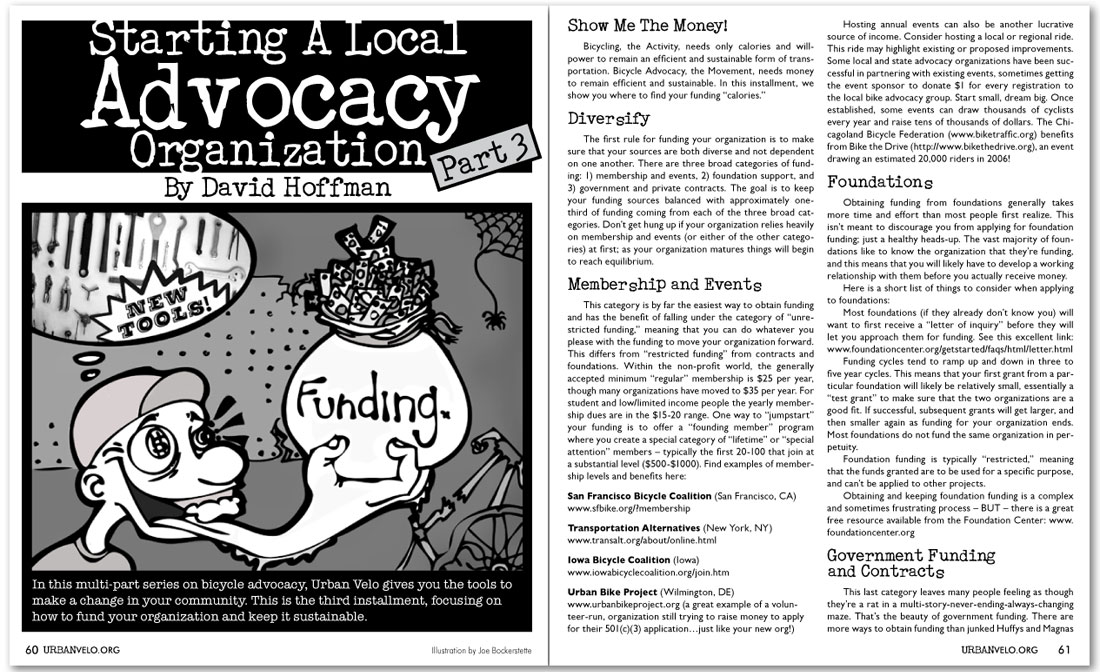Starting a Local Advocacy Organization - Part III
By David Hoffman
In this multi-part series on bicycle advocacy, Urban Velo gives you the tools to make a change in your community. This is the third installment, focusing on how to fund your organization and keep it sustainable.
Show Me The Money!
Bicycling, the Activity, needs only calories and willpower to remain an efficient and sustainable form of transportation. Bicycle Advocacy, the Movement, needs money to remain efficient and sustainable. In this installment, we show you where to find your funding “calories.”
Diversify
The first rule for funding your organization is to make sure that your sources are both diverse and not dependent on one another. There are three broad categories of funding: 1) membership and events, 2) foundation support, and 3) government and private contracts. The goal is to keep your funding sources balanced with approximately one-third of funding coming from each of the three broad categories. Don’t get hung up if your organization relies heavily on membership and events (or either of the other categories) at first; as your organization matures things will begin to reach equilibrium.
Membership and Events
This category is by far the easiest way to obtain funding and has the benefit of falling under the category of “unrestricted funding,” meaning that you can do whatever you please with the funding to move your organization forward. This differs from “restricted funding” from contracts and foundations. Within the non-profit world, the generally accepted minimum “regular” membership is $25 per year, though many organizations have moved to $35 per year. For student and low/limited income people the yearly membership dues are in the $15-20 range. One way to “jumpstart” your funding is to offer a “founding member” program where you create a special category of “lifetime” or “special attention” members – typically the first 20-100 that join at a substantial level ($500-$1000). Find examples of membership levels and benefits here:
San Francisco Bicycle Coalition (San Francisco, CA)
Transportation Alternatives (New York, NY)
Iowa Bicycle Coalition (Iowa)
Urban Bike Project (Wilmington, DE)
(a great example of a volunteer-run, organization still trying to raise money to apply for their 501(c)(3) application…just like your new org!)
Hosting annual events can also be another lucrative source of income. Consider hosting a local or regional ride. This ride may highlight existing or proposed improvements. Some local and state advocacy organizations have been successful in partnering with existing events, sometimes getting the event sponsor to donate $1 for every registration to the local bike advocacy group. Start small, dream big. Once established, some events can draw thousands of cyclists every year and raise tens of thousands of dollars. The Chicagoland Bicycle Federation (www.biketraffic.org) benefits from Bike the Drive (http://www.bikethedrive.org), an event drawing an estimated 20,000 riders in 2006!
Foundations
Obtaining funding from foundations generally takes more time and effort than most people first realize. This isn’t meant to discourage you from applying for foundation funding; just a healthy heads-up. The vast majority of foundations like to know the organization that they’re funding, and this means that you will likely have to develop a working relationship with them before you actually receive money.
Here is a short list of things to consider when applying to foundations:
Most foundations (if they already don’t know you) will want to first receive a “letter of inquiry” before they will let you approach them for funding. See this excellent link: www.foundationcenter.org/getstarted/faqs/html/letter.html
Funding cycles tend to ramp up and down in three to five year cycles. This means that your first grant from a particular foundation will likely be relatively small, essentially a “test grant” to make sure that the two organizations are a good fit. If successful, subsequent grants will get larger, and then smaller again as funding for your organization ends. Most foundations do not fund the same organization in perpetuity.
Foundation funding is typically “restricted,” meaning that the funds granted are to be used for a specific purpose, and can’t be applied to other projects.
Obtaining and keeping foundation funding is a complex and sometimes frustrating process – BUT – there is a great free resource available from the Foundation Center: www.foundationcenter.org
Government Funding and Contracts
This last category leaves many people feeling as though they’re a rat in a multi-story-never-ending-always-changing maze. That’s the beauty of government funding. There are more ways to obtain funding than junked Huffys and Magnas (continued) |

